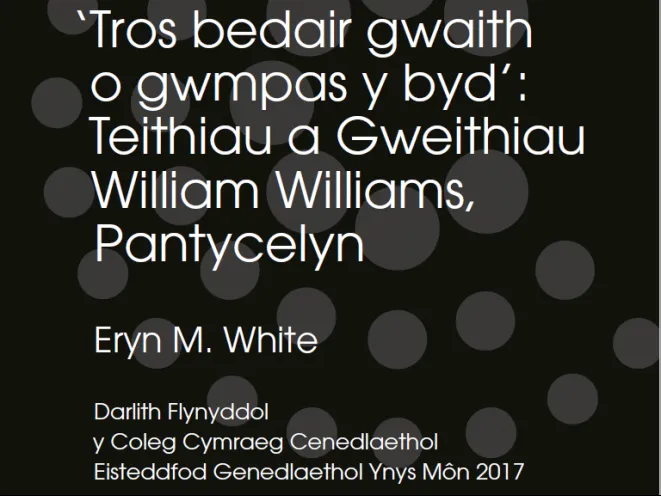Cynhaliwyd cynhadledd Pontydd Cyfieithu ym Mhrifysgol Aberystwyth ar 19 Ionawr 2017. Yma, ceir rhaglen y gynhadledd ynghyd â ffeiliau sain a/neu fideo o bob cyflwyniad neu sesiwn. Cliciwch ar Cyfryngau Cysylltiedig uchod i lawrlwytho'r ffeiliau.
Cynhadledd Pontydd Cyfieithu
Cynhadledd Ryngwladol 2014
Yn y casgliad hwn ceir cyflwyniadau o Gynhadledd Ryngwladol y Coleg Cymraeg Cenedlaethol, 1-3 Gorffennaf 2014. 'Pa le i'n hiaith mewn Addysg Uwch?' oedd thema'r gynhadledd ac mae'r cyflwyniadau'n ymwneud yn bennaf â pholisi iaith ac addysg yng Nghymru ac Ewrop.
Cynhadledd Wyddonol 2019
Cynhaliwyd Cynhadledd Wyddonol 2019 yng Nghanolfan Medrus, Prifysgol Aberystwyth, ar 6 Mehefin 2019. Roedd y gynhadledd yn gyfle i gyflwyno'r ymchwil gwyddonol ddiweddaraf trwy gyfrwng y Gymraeg. Yma ceir casgliad o gyflwyniadau a fideos o'r gynhadledd.
Cynhadledd Ymchwil Seicoleg 2013
Cynhaliwyd cynhadledd ymchwil cyfrwng Cymraeg gyntaf yr Ysgol Seicoleg ym Mangor ar 4 Tachwedd 2013. Dr Carl Hughes oedd y prif areithiwr, yn areithio ar Newid Ymddygiad. Gellir lawrlwytho copiau o'r cyflwyniadau Pwerbwynt o dan bob cyflwyniad fideo.Traddodwyd ar ystod eang o bynciau amrywiol: Amy Hulson Jones: 'Gwella sgiliau darllen sylfaenol' Awel Vaughan Evans: 'Trosglwyddiad gramadegol rhwng y Gymraeg a'r Saesneg' Catherine Sharp: 'Y Food Dudes. Y Rhaglen Blynyddoedd Cynnar. Astudiaeth Gwerthuso wedi ei Rheoli' Ceri Ellis: 'Allwn ni gynnal cred mewn un iaith, ond nid y llall? Astudiaeth o gredoau diwylliannol ac emosiynol mewn pobl ddwyieithog Cymraeg-Saesneg' Denise Foran: 'Canlyniadau plant a dderbyniodd ymyriad ABA dwysder isel mewn ysgol anghenion arbennig' Dr Carl Hughes: 'Newid Ymddygiad: Be di'r Broblem?' Dr Leah Jones: 'Ymwybyddiaeth Ofalgar er lles rhieni plant ag anableddau deallusol a datblygiadol: datblygu mesurau cyfrwng Cymraeg ar gyfer ymchwil iechyd meddwl' Dr Nia Griffith: 'Ymchwilio'r Blynyddoedd Cynnar yng Nghymru' Ela Cernyw: 'Lles seicolegol rhieni sy'n siarad Cymraeg a gyda phlentyn ag anabledd dysgu' Emma Hughes: 'Gyffredinoli trawsieithyddol o effaith therapi mewn anomia dwyieithog Cymraeg-Saesneg' Yvonne Moseley: 'Datblygu rhaglen ddarllen Cymraeg yn seiliedig ar wybodaeth, tystiolaeth ac ymchwil'
The early response to Williams Pantycelyn by Saunders Lewis
Saunders Lewis’ Williams Pantycelyn (1927) was the most exciting and controversial work of literary criticism to appear in twentieth century Welsh letters. In ten memorable and often brilliant chapters, Lewis analysed the work of the eighteenth century hymnist not according to the usual Protestant norms but in terms of medieval Catholic mysticism on the one hand and the then novel Freudian and Jungian psychology on the other. The book caused a literary and critical storm. Among those who affirmed its counterintuitive nature was the poet T. Gwynn Jones; its thesis was rejected by the philosopher E. Keri Evans while the preacher-poet Moelwyn Hughes found the volume objectionable in the extreme. Such was the power of Lewis’ analysis, however, that for more than a generation it came to embody a new orthodoxy in the scholarly understanding of William Williams. It was not until the 1960s that this orthodoxy began to be overturned. The accompanying essay describes how this process evolved.
Y Gors [The Bog]: examining the boundary between authorship and contribution in documentary film
In answer to a call by the Arts and Humanities Research Council, and with the support of the Coleg Cymraeg Cenedlaethol, Anne Marie Carty, Nick Jones and Dafydd Sills-Jones made a poetic/experimental documentary film in 2016, on the subject of Cors Fochno, near Borth. Cors Fochno is one of Western Europe’s major peat bogs, is home to a unique ecology, and also home to important scientific study, not least into climate change. The bog was therefore a useful filmic metaphor for a number of issues and perspectives, including the feelings of the local community towards wilderness, the sustainability of local farming, and more broadly the history and future of human relationship with the environment. The article traces the approaches and concepts behind the film, and by doing so places it in the tradition of ‘practice-as-research’.
Historicising production studies: Teliesyn’s second stage through the lenses of Cottle, Bourdieu and Berne
Dros y deng mlynedd diwethaf, mae ‘astudiaethau cynhyrchu cyfryngau’ wedi tyfu’n sylweddol fel is-ddisgyblaeth. Yn sgil hyn, mae’r drafodaeth arferol ar y ddynameg rhwng technoleg, economi, ffurfiau diwylliannol, creadigrwydd a gyrfaoedd proffesiynol wedi eu trawsnewid, gan herio hen begynau disgyrsiol economi gwleidyddol ac astudiaethau diwylliannol. Er hynny, mae gogwydd cyfoes i’r datblygiadau hyn, sy’n aml yn anwybyddu hanes y cyfryngau. Mae’r erthygl hon yn ceisio defnyddio agwedd ‘astudiaethau cynhyrchu cyfryngau’ (wrth ddefnyddio fframweithiau cysyniadol Simon Cottle, Pierre Bourdieu ac Eric Berne) er mwyn olrhain hanes un o brif gwmnïau teledu Cymru, Teliesyn.
Design of a ‘Dual Wavelength Laser’
This article is based upon the idea of designing a laser that can emit light at two different wavelengths, at the same time. This kind of laser has already been produced in the past; however, the difference between the two wavelengths was much larger. We intend to reduce this difference, while still being able to emit at two different wavelengths. This article will also address the effects of linewidth broadening where it is important to know how close the two wavelengths can be before we only see one broad peak in the spectrum, rather than two individual narrow peaks. Doing this will allow us to generate terahertz radiation from just one laser source.
Darlith Flynyddol 2011: Seiliau Cyfansoddiadol y Ddeddfwrfa Gymreig
Darlith Flynyddol y Coleg Cymraeg Cenedlaethol 2011: Seiliau Cyfansoddiadol y Ddeddfwrfa Gymraeg, gan yr Athro Richard Wyn Jones. Traddodwyd y ddarlith yn Eisteddfod Genedlaethol Wrecsam a'r Fro.
Darlith Flynyddol 2012: Canrif Gwynfor – Melancoli, Moderniaeth a Bro Gymraeg
Darlith Flynyddol y Coleg Cymraeg Cenedlaethol 2012: Canrif Gwynfor - Melancoli, Moderniaeth a Bro Gymraeg, gan Rhys Evans Traddodwyd y ddarlith yn Eisteddfod Genedlaethol Bro Morgannwg.
Darlith Flynyddol 2015: Y Wladfa 1865–2015 – Dathlu Beth?
Darlith Flynyddol y Coleg Cymraeg Cenedlaethol 2015: Y Wladfa 1865-2015 - Dathlu Beth? gan Elvey MacDonald. Traddodwyd y ddarlith yn Eisteddfod Genedlaethol Maldwyn a'r Gororau ar ddydd Mawrth 5 Awst 2015.
Darlith Flynyddol 2017: 'Tros bedair gwaith o gwmpas y byd': Teithiau a Gweithiau William Williams, Pantycelyn
Darlith Flynyddol y Coleg Cymraeg Cenedlaethol 2017: 'Tros bedair gwaith o gwmpas y byd': Teithiau a Gweithiau William Williams, Pantycelyn, gan Eryn White, Prifysgol Aberystwyth. Traddodwyd y ddarlith yn Eisteddfod Genedlaethol Môn ar ddydd Mawrth 8 Awst 2017.












